Writerly AI
Description: Writerly AI is a powerful and versatile writing tool platform that uses AI content generation to create niched content. Writerly AI’s deep learning algorithms and machine learning techniques can help with analyzing millions of articles and determine what makes it a great content. Writerly AI is the perfect tool for creating text material on your website, SEO-optimized pages, Instagram stories, copyrighting and more.
Architecture description: Writerly AI is a cloud-based AI writing assistant that combines machine learning and natural language processing to help users create outstanding texts. Its architecture consists of a unified harmonious system including the frontend part, the backend part and machine learning models.
Frontend: The frontend allows users to interact with the application through its layout which is composed of the place where users can write and edit the text, navigation bars, settings and the rest of the application. Writerly AI is built using modern technologies like React, Redux and Node.js.
Backend: The backend usually processes the requests from the users and generates responses for users. The backend consists of services or microservices used to extract or add details on the frontend side. Each microservice is responsible with a dedicated task such as grammar checking, style or tone recommendations, improving text and more.
Machine learning models: The machine learning models are the core functionalities of almost any artificial intelligence platforms from the market. The models are trained on massive datasets of data (such as text, numbers, code) and used to generate relevant and accurate responses. Machine learning models use two main components: an encoder and a decoder. The encoder and decoder are trained on a large corpus of poetry texts of different languages, genres and authors. The architecture is similar to the Transformer model, which has multilayer attentional and positional encoding. The number of layers, the size of the hidden state and the number of parameters depend on the particular implementation of the model.
The encoder converts the user's request into a vector representation that contains information about the desired characteristics of the poetry.
The decoder generates the text of the poetry word by word using the vector representation as a condition.
Main advantages: Writerly AI has several advantages such as:
User-friendly interface: Writerly AI has an intuitive and user-friendly interface, easy to understand and work with. Its simple interface can make the using and learning processes smoother, offering users extra time to focus on other important tasks.
Three writing modes: Writerly AI can write content for different backgrounds and individual writing styles, such as “Articles”, “Stories” and “Academics”, making it a versatile tool for a large spectrum of users.
Text editing and proofreading: Writerly AI’s advanced editing and proofreading skills can catch any errors and inconsistencies missed by manual work, saving a lot of time and effort.
High accuracy: Writerly AI can generate enhanced accuracy and consistency in its texts, free of errors and typos. Can offer suggestions for sentence structure improvements, grammar, punctuation and relevancy. The output is a well-done, clean and polished content.
Efficiency in dealing with big data: Writerly AI uses neural networks that can process large amounts of text data and extract useful information from it such as summarization.
Flexibility and customization: Writerly AI allows users to choose from advanced settings options for specific assistance like generating ideas, new creative content, niched content and other suggestions.
Limitations and Disadvantages: Writerly AI also has some limitations and disadvantages such as:
Limited capability: Writerly AI is still under development, meaning the AI is currently learning, which can be though in the competing world of more mature AI systems. So far, it has a limitation regarding the options of tone and styles and other advanced features for specialized content such as emails, website content, marketing-specific content.
Limited creativity: Writerly AI may have difficulty generating creative content such as poetry on rare or specific topics for which there is insufficient training data.
Unpredictability and inconsistency: Writerly AI may generate text and content that does not always make sense, have logic or quality. Content may be unoriginal, repetitive, or contain errors.
Language limitations: Writerly AI was initially designed in english language and this aspect might limit its usefulness for other non-english-writers who do not understand english. Currently the platform supports 25 languages, but the quality of the content might differ.
Examples of uses: Writerly AI can be used for a variety of purposes such as:
Key technical features:
NLP (Natural Language Processing): Writerly AI depends on the natural language processing to understand and generate text structures. NLP is used for text analysis, machine translation or speech recognition, helping users create engaging, relevant, accurate and factual texts based on detailed prompt descriptions.
ML (Machine Learning): Machine learning is used almost on all AIs to help them learn from large datasets of data such as texts, numbers, scripts, codes and so. Writely AI uses machine learning to learn from the available datasets and generate high-quality contents in response.
DL (Deep Learning): Deep Learning is used to create complex models of language and writing. Writerly AI uses DL to create human-like content including abilities such as tone, accents, writing styles, grammar and other fine aspects.
LLMs (Large Language Models): LLMs have the ability to offer creative content, answer complex questions, translate languages, generate niched texts in various styles, offer factual and informative responses and many more.
Software Architecture
Writerly AI is a cloud-based writing service divided into scalable and reliable layers such as presentation layer, application layer and data layer. All these layers have been built using different programming languages, tools and libraries including:
The Presentation layer, in other words the frontend part of Writerly AI, where users interact with the interface of the application, was implemented using software tools such as React, Redux and Node.js.
The Application layer, or the core functionalities of Writerly AI, is responsible with the logic of the application such as tasks generating content, editing texts, providing enhancements or analytics. The application layer is built using Python, TensorFlow and PyTorch technologies.
The Data layer of Writerly AI is responsible with manipulating data, such as storing and retrieving specific data. The Data layer is implemented in PostgreSQL, Redis and Elasticsearch.
Programming Languages
React: React programming language, used to develop the interface of Writerly AI is actually a modern Javascript library used for building web interfaces and single-page applications (SPA). React can create fast and responsive web pages, making them easy to use and navigate.
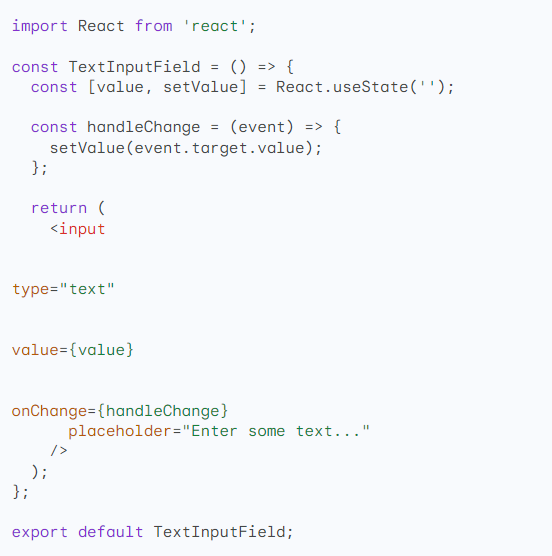
The above code snippet creates a simple text input that allows users to enter text. The handleChange() method is triggered each time the user modifies the text. The value is updated each time with the user's text change.
Redux: Redux programming language is also a Javascript state management library useful for managing the state of the applications, including the content that is being created and modified and user preferences.
Node.js: Node.js is a runtime environment used by Writerly AI to run the applications server which is responsible with handling different HTTP requests from the users and specific responses.
Python: Writerly AI uses Python as the main programming language to develop its engine because of its simplicity and versatility compared to other programming languages. Python can be used for a great variety of tasks, such as data processing or model training.
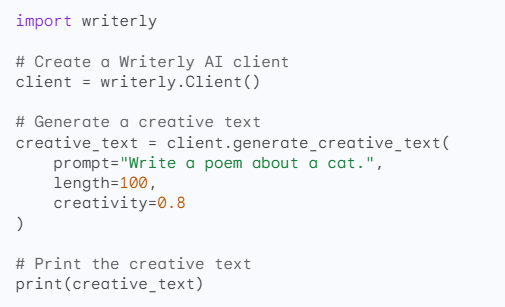
The above code snippet uses the Writerly AI services to generate a creative text about a poem of a cat. Using the Writerly client service, we can access its creative functionality to display any creative content such as poems, stories or musical pieces. In order to generate stories or musical pieces, you can change the code and play around, just changing the text prompt such as: prompt="Write a musical piece in the style of Beethoven's Moonlight Sonata."
The output result will display a creative poem about a cat, like:

Tools and libraries
Writerly AI can use different frameworks to implement its text generation models, such as:
TensorFlow: Writerly AI uses TensorFlow together with Python library, to provide a stable Python API and help load data to train the model and deploy it in production environment using TensorFlow Serving. Check the following code snippet representing a TensorFlow Serving server integration:
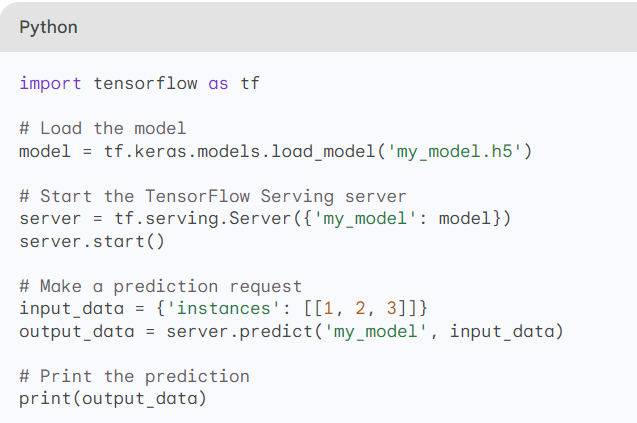
The above code loadsa model called my_model.h5 and starts the TensorFlow Serving server. The next line of code will make a prediction request to the server using the tf.serving.predict() function which takes some parameters like the name of the model and the input data, returning the prediction as an output. For making prediction requests, TensorFlow Serving provides a dedicated REST API. You can send a POST request in JSON format to the following endpoint: /v1/docs.html/{model_name}:predict
The output result consists of the prediction made displayed in the JSON format.
Pytorch: Writerly AI uses Pytorch open-source library for machine learning models based on Torch library and designed in a modular and flexible manner, so that it can easily optimize and speed up processes and operations. Writerly AI uses Pytorch for various tasks like text analysis, natural language processing and speech recognition.
Example of using Pytorch library together with Writerly AI services:
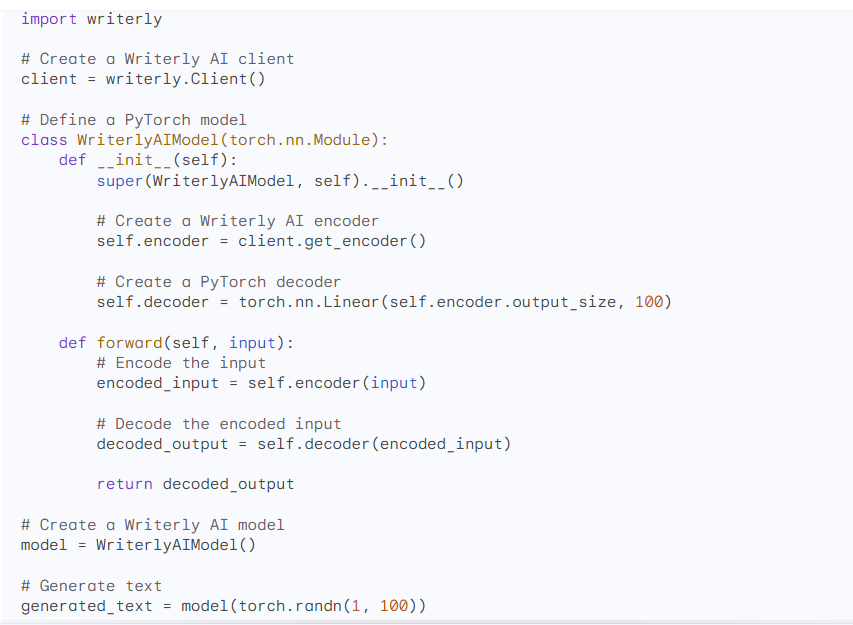
The above code will generate a short story using the PyTorch library to create complex models and generate realistic, factual and engaging stories. The Writerly client is triggered again to access the API available functions of the service, while the PyTorch encodes the input text into a latent representation and the decoder function, transforms the latent representation into text.
Model Transformers: Model Transformers library is used on pre-training the model Writerly AI uses. Model Transformers is used for the natural language processing (NLP) capability on various tasks such as text analysis and other creative content. Providing a wide range of pre-trained language models and other NLP tools, the pre-trained models can perform various tasks, such as text recognition, text classification, object detection and many more.
Example of using Model Transformers using Python programming language:

The above example code shows how the Model Transformes library can load the AI model and prompt a request to write a Python function that reverses a string and generates a completion afterwards. The output result from the console will print the reversed string, up to 100 tokens long in the Python programming language.
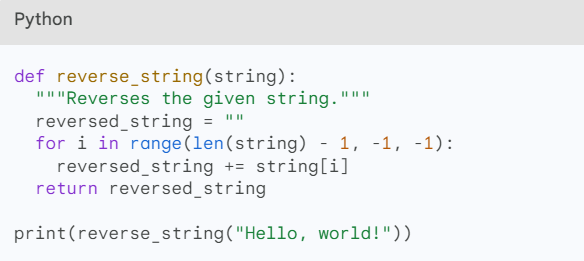
Elasticsearch: Writerly AI uses Elasticsearch tool to search and analyze large volumes of texts and indexes, making it easier for users to find and discover the information they asked for. This can help users find the information they need more quickly and easily.
Selection guidelines: the choice of using Writerly AI depends on the specific purpose and goal of each individual person and business that uses text generation. Some factors to consider while selecting a framework are:
- Task complexity and scope: some frameworks may be more appropriate for complex or large tasks that require high accuracy or efficiency than others.
- Availability and support for code and data: some frameworks may have better or more up-to-date code or data than others, as well as a more active developer or user community.
- Flexibility and extensibility: some frameworks may be more flexible or extensible than others, allowing you to easily add new features or modify existing ones.
- Creativity: some frameworks may be more capable in creating human-like-text than other frameworks, taking into account free-text or creative texts.
Known Notes
Writerly AI is a fast-growing AI writing platform that includes several features that distinguish it from other text generation services. Writerly AI its already a well known and recognized AI platform that has lately made a great impact around the world.
Writerly AI was developed by a team experienced in artificial intelligence and NLP (natural language processing) researchers and soon became one of the “10 Best AI-Powered Writing Tools” nominated by Forbes.
Writerly AI raises in 2020 $1 million in seed funding, $5 million in Series A funding and $10 million in 2022 for Series B funding.
Writerly AI is named in 2023 is named one of the “50 Best AI Products of 2023” by the Time Magazine.
Writerly AI supports over 25 languages including Russian, English, French, Spanish, German, Chinese and more. Users can choose the language for their bots and switch between them at any time. Writerly AI is currently working on adding new languages.
Writerly AI is expected to launch in 2024 its own chatbot available for users, regardless of their subscription plan.
Writerly AI offers a few subscription plans divided into two categories: Creator Cloud Plans and Business Cloud Plans.
Creator Cloud Plans (dedicated for individuals and small teams, priced with $0 - $34/month), including services such as 1 creator, unlimited usage, drive storage, support, core personas, smart brand personas, 50+ GPT templates and many more.
Business Cloud Plans (dedicated for businesses and enterprise, where prices vary from $69 - $219). The services included contain up to 20 team members, unlimited usage and drive storage, core and smart brand personas, 50+ GPT templates, templates and other features.
Writerly AI integrates with other platforms and services such as Google Chrome, Wordpress, Shopify, WooCommerce and is currently working on developing integrations with Squarespace, Magento and HubSpot.
Application Examples
Known Applications: Writerly AI’s services are already used by several large companies around the world, including:
Forbes: Forbes is currently using Writerly AI services to generate its blog posts, articles and other content for their website.
TechCrunch: Writerly AI offers services to the TechCrunch company as well, services including text generation for their newsletters, articles, blog posts and such.
HubSpot: HubSpot benefits from using Writerly AI custom services such as landing pages creation, email marketing campaigns and other marketing materials.
Salesforce: Salesforce uses Writerly AI to analyze, generate sales proposals, create business documents, offer customer support documentation and so on.
IBM: IBM is using Writerly AI to enhance users experience such as marketing materials for their Watson AI platform, generate great product descriptions, technical documentations and other niched text materials.